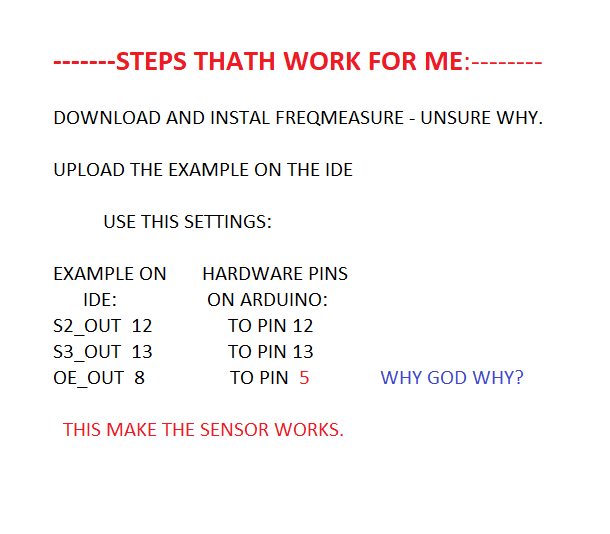First of all, Hi and thanks for all the insights.
A frien of mine neeed to activate a relay, on a color change on a monitor, no porblem there, there are 3 mayor colors; green for pass, black for wait (non activate) and red (non active).
Im trying to use an TCS230 sensor for the color readings.
At first when on:
This simple example, and the sensor star to works, read some values and stuff.
when I tried to read some specific color, the fun begun, and shortly I realize I migth need a very good Lib for the Job.
Fortunately, I fount this one:
It has many interesting features, like the fact for start, that has a "calibration", for read more accurately.
And the capacity for read color and label them for the use in the program.
An here is were I need some of you help.
I tried to wire like the previous example, and in the begging I was very unsure, because in the first example of circuit today they use 6 wire, and in the library code they only mention 3 wires.
Long story short:
The sensor has to be wired correctly, and the sensor has a hardware problem.
This are the tips I can found use the web:
1.- In the use of the library, the sensor might be modify, (There is a PDF on the Library download folder, more details in there).
2.- This is a library uses another, called FreqCounter, more on this on This thread and for the use of this library, you have to check the rigth hardware pin to be used (as not all of them are usable for this purpose). There is a
I pin the sensor as follows:
S0 - VCC
S1 - VCC
OUT - PIN 5
S3 - pin 10
s4 - pin 11
vcc - vcc
gnd -gnd
I tried the calibration, and I get color is RGB[0,0,0]
So, I modify the sensor, tried again and still get the same error.
I search and some people were correcting they errors by choosing the rigth output pin, in this case the 5, (Im using arduino UNO).
this is the code;
// TCS230 sensor calibration and color readings
//
// Input and output using the Serial console.
//
#include <MD_TCS230.h>
#include <FreqCount.h>
#define BLACK_CAL 0
#define WHITE_CAL 1
#define READ_VAL 2
// Pin definitions
#define S2_OUT 11
#define S3_OUT 10
#define OE_OUT 5 // LOW = ENABLED
MD_TCS230 CS(S2_OUT, S3_OUT, OE_OUT);
void setup()
{
Serial.begin(57600);
Serial.print(F("\n[TCS230 Calibrator Example]"));
CS.begin();
}
char getChar()
// blocking wait for an input character from the input stream
{
while (Serial.available() == 0)
;
return(toupper(Serial.read()));
}
void clearInput()
// clear all characters from the serial input
{
while (Serial.read() != -1)
;
}
uint8_t fsmReadValue(uint8_t state, uint8_t valType, uint8_t maxReads)
// Finite State Machine for reading a value from the sensor
// Current FSM state is passed in and returned
// Type of value being read is passed in
{
static uint8_t selChannel;
static uint8_t readCount;
static sensorData sd;
switch(state)
{
case 0: // Prompt for the user to start
Serial.print(F("\n\nReading value for "));
switch(valType)
{
case BLACK_CAL: Serial.print(F("BLACK calibration")); break;
case WHITE_CAL: Serial.print(F("WHITE calibration")); break;
case READ_VAL: Serial.print(F("DATA")); break;
default: Serial.print(F("??")); break;
}
Serial.print(F("\nPress any key to start ..."));
state++;
break;
case 1: // Wait for user input
getChar();
clearInput();
state++;
break;
case 2: // start the reading process
CS.read();
state++;
break;
case 3: // wait for a read to complete
if (CS.available())
{
sensorData sd;
colorData rgb;
switch(valType)
{
case BLACK_CAL:
CS.getRaw(&sd);
CS.setDarkCal(&sd);
break;
case WHITE_CAL:
CS.getRaw(&sd);
CS.setWhiteCal(&sd);
break;
case READ_VAL:
CS.getRGB(&rgb);
Serial.print(F("\nRGB is ["));
Serial.print(rgb.value[TCS230_RGB_R]);
Serial.print(F(","));
Serial.print(rgb.value[TCS230_RGB_G]);
Serial.print(F(","));
Serial.print(rgb.value[TCS230_RGB_B]);
Serial.print(F("]"));
break;
}
state++;
}
break;
default: // reset fsm
state = 0;
break;
}
return(state);
}
void loop()
{
static uint8_t runState = 0;
static uint8_t readState = 0;
switch(runState)
{
case 0: // calibrate black
readState = fsmReadValue(readState, BLACK_CAL, 2);
if (readState == 0) runState++;
break;
case 1: // calibrate white
readState = fsmReadValue(readState, WHITE_CAL, 2);
if (readState == 0) runState++;
break;
case 2: // read color
readState = fsmReadValue(readState, READ_VAL, 1);
break;
default:
runState = 0; // start again if we get here as something is wrong
}
}
But I cant figure out, were is the error.
Any help will be appreciated.
-Alex.



